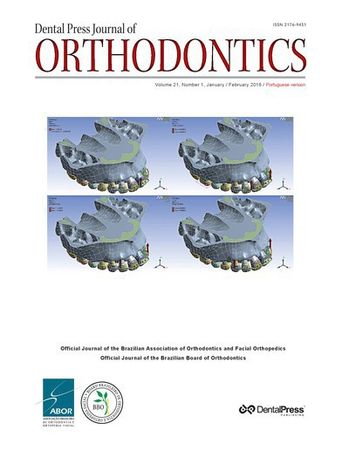Systematic reviews: knowledge translation?
Systematic reviews are reproducible synthesis of the best available evidence to facilitate sounder clinical decisions. From the triad of factors that encompass evidence-based Dentistry — clinician’s experience, patient’s needs and preferences, available scientific evidence — systematic...
Autores: Carlos Flores Mir,
messages.RevistaAutores:
LEIA MAIS
orthodontics highlights
We orthodontists, more than anyone, know the importance of a good occlusion, not only for the aesthetic aspect, but also for the functional one. Recent studies have shown unprecedented and revealing results demonstrating how much malocclusion influences social relations between individuals. From...
Autores: Matheus Melo Pithon,
messages.RevistaAutores:
LEIA MAIS
Therapeutic expectations: Dentistry relies less on dental plaque as a major etiological factor OR On the dental needs of young orthodontic patients (12-20 years old)
In Brazilian cities and states governed efficiently with wealth ethically administered, carious and periodontal diseases have prevalence rates similar to those found in socially developed European countries. This shift in reality, noticed over the last 15 years, reflects on changes in the...
Autores: Alberto Consolaro, Leopoldino Capelozza Filho, Daniele Nóbrega Nardoni, Paulo Henrique X. Franco, José Antônio Z. Cappellozza,
messages.RevistaAutores: caries, periodontal disease , Orthodontic planning, Etiology, Dental trauma,
LEIA MAIS
An interview with Hyeon-Shik Hwang
It gives me great pleasure to interview Dr. Hyeon-Shik Hwang, an innovative orthodontist who has developed many creative techniques over his career. Dr. Hwang was born in Korea and received his DDS and PhD degrees from Yonsei University in Seoul. He is professor and chairman of the Department of...
Autores: Guilherme Thiesen, Telma Martins De Araújo, Maria Perpétua Mota Freitas, Alexandre Trindade Simões Da Motta,
messages.RevistaAutores:
LEIA MAIS
Evaluation of upper airways after bimaxillary orthognathic surgery in patients with skeletal Class III pattern using cone-beam computed tomography
Introduction: It has been suggested that mandibular setback surgery, combined or not with maxillary advancement as a treatment alternative for patients with mandibular prognathism, can induce changes in upper airway space (UAS). Therefore, this study aimed to assess the response of the upper...
Autores: André Wilson Machado, Marcos Alan Vieira Bittencourt, Lucas Senhorinho Esteves, Inessa Da Silva Barbosa, Vanessa Álvares Castro Rocha, Marília Spínola Azevêdo,
messages.RevistaAutores: cone-beam computed tomography, Orthognathic surgery, Obstructive sleep apnea, Airway remodeling,
LEIA MAIS
Deflection test evaluation of different lots of the same nickel-titanium wire commercial brand
Introduction: The aim of this in vitro study was to compare the elastic properties of the load-deflection ratio of orthodontic wires of different lot numbers and the same commercial brand. Methods: A total of 40 nickel-titanium (NiTi) wire segments (Morelli OrtodontiaTM - Sorocaba, SP, Brazil),...
Autores: Júlio De Araújo Gurgel, Gustavo Antônio Martins Brandão, Fabrício Viana Pereira Lima, Célia Regina Maio Pinzan-Vercelino, Murilo Gaby Neves, Fernanda Soares Rezende,
messages.RevistaAutores: Orthodontic wires, Physical Properties, Elasticity,
LEIA MAIS
Nasal septum changes in adolescent patients treated with rapid maxillary expansion
Objective: To analyze cone-beam computed tomography (CBCT) scans to measure changes in nasal septal deviation (NSD) after rapid maxillary expansion (RME) treatment in adolescent patients. Methods: This retrospective study involved 33 patients presenting with moderate to severe nasal septum...
Autores: Carlos Flores Mir, Tehnia Aziz, Francis Carter Wheatley, Kal Ansari, Manuel Lagravere, Michael Major,
messages.RevistaAutores: Cbct, Rapid maxillary expansion, Rapid palatal expansion, Nasal septum,
LEIA MAIS
Frequency of orthodontic extraction
Introduction: The option of dental extraction for orthodontic purposes has been debated for more than 100 years, including periods when it was widely used in treatment, including the present, during which other methods are used to avoid dental extractions. The objective was to analyze the...
Autores: Jonas Capelli Júnior, Camila De S. Dardengo, Luciana Q. P. Fernandes,
messages.RevistaAutores: Tooth extraction, Orthodontics, Epidemiology,
LEIA MAIS
Judging orthodontic treatment complexity
Objective: The aim of the present study was to investigate possible relations between anticipated overall treatment complexity (AOTC) of an orthodontic case and malocclusion characteristics. Methods: Two groups of orthodontists (groups A and B) were asked to define perceived treatment complexity...
Autores: Aly Medhat, An De Geest, Johannes Van Gastel, Annelies Kellens, Steffen Fieuws, Guy Willems, Maïté Clijmans,
messages.RevistaAutores: Orthodontic treatment complexity, Orthodontic indices,
LEIA MAIS
Evaluation of long-term stability of mesiodistal axial inclinations of maxillary molars through panoramic radiographs in subjects treated with Pendulum appliance
Objective: To evaluate the stability of mesiodistal inclination of maxillary molars produced by a pendulum appliance, five years after completion of orthodontic treatment. Angulation changes were compared to an untreated sample. Methods: The sample consisted of 20 patients (14 females and 6...
Autores: Marcio Rodrigues de Almeida, Renato Rodrigues De Almeida, José Fernando Castanha Henriques, Carlos Flores Mir, Caroline Andrade Rocha,
messages.RevistaAutores: Orthodontic appliances, Angle Class II malocclusion, Radiography,
LEIA MAIS
Orthodontic intrusion of maxillary incisors: a 3D finite element method study
Objective: In orthodontic treatment, intrusion movement of maxillary incisors is often necessary. Therefore, the objective of this investigation is to evaluate the initial distribution patterns and magnitude of compressive stress in the periodontal ligament (PDL) in a simulation of orthodontic...
Autores: Hiroshi Maruo, Armando Yukio Saga, Orlando Motohiro Tanaka, Ivan Toshio Maruo, Marco André Argenta,
messages.RevistaAutores: Orthodontics, Finite element analysis, Tooth intrusion,
LEIA MAIS
The influence of distal-end heat treatment on deflection of nickel-titanium archwire
Objective: The aim of this in vitro study was to evaluate the deflection-force behavior of nickel-titanium (NiTi) orthodontic wires adjacent to the portion submitted to heat treatment. Material and Methods: A total of 106 segments of NiTi wires (0.019 x 0.025-in) and heat-activated NiTi wires...
Autores: Júlio De Araújo Gurgel, Marcelo Faria Da Silva, Célia Regina Maia Pinzan-Vercelino,
messages.RevistaAutores: Orthodontic wires, Mechanical properties, Heat treatment,
LEIA MAIS
3D virtual planning in orthognathic surgery and CAD/CAM surgical splints generation in one patient with craniofacial microsomia: a case report
Objective: In this case report, the feasibility and precision of tridimensional (3D) virtual planning in one patient with craniofacial microsomia is tested using Nemoceph 3D-OS software (Software Nemotec SL, Madrid, Spain) to predict postoperative outcomes on hard tissue and produce CAD/CAM...
Autores: Francisco Vale, Jessica Scherzberg, David Sanz, Francisco Caramelo, Luísa Maló, João Pedro Marcelino, João Cavaleiro,
messages.RevistaAutores: cad/cam, Orthognathic surgery, 3D surgical splint,
LEIA MAIS
Class II, Division 1 Angle malocclusion with severe proclination of maxillary incisors
Protrusion of maxillary incisors is a common complaint among patients seeking orthodontic treatment. This report addresses the correction of Class II Angle malocclusion with excessively bucally proclined maxillary incisors, in an adolescent female patient, through the use of extraoral and fixed...
Autores: Kátia Montanha Andrade,
messages.RevistaAutores: Corrective Orthodontics, Class II Angle malocclusion, Orthodontic headgear,
LEIA MAIS
Why segment the maxilla between laterals and canines?
Introduction: Maxillary surgery on a bone segment enables movement in the sagittal and vertical planes. When performed on multiple segments, it further provides movement in the transverse plane. Typical sites for interdental osteotomies are between laterals and canines, premolars and canines, or...
Autores: Lucas Senhorinho Esteves, Carolina ávila, Jean Nunes Dos Santos, Steven M. Sullivan, Luana Maria Rosário Martins,
messages.RevistaAutores: Orthognathic surgery, Anterior segmental maxillary osteotomy, Dentoskeletal deformities,
LEIA MAIS



